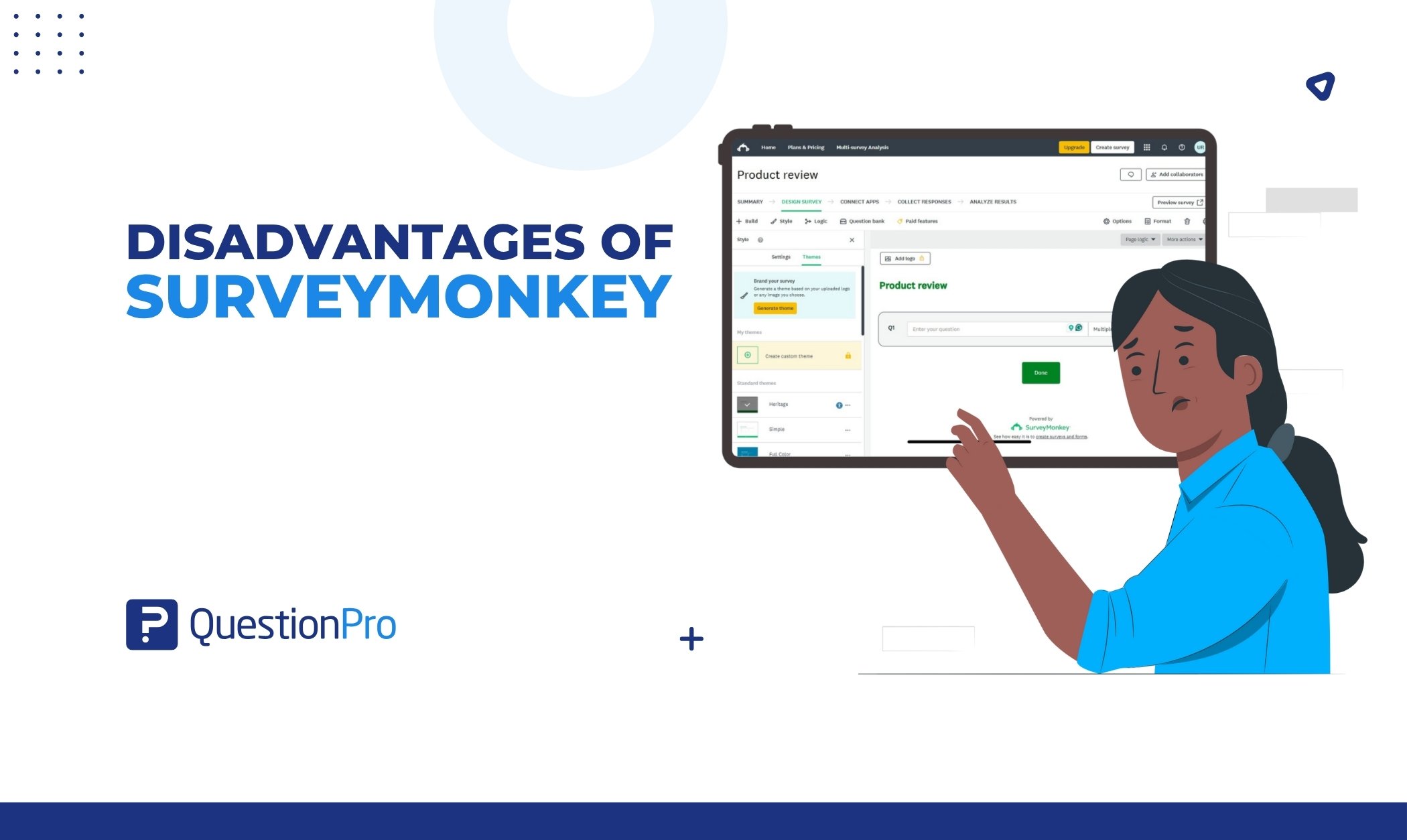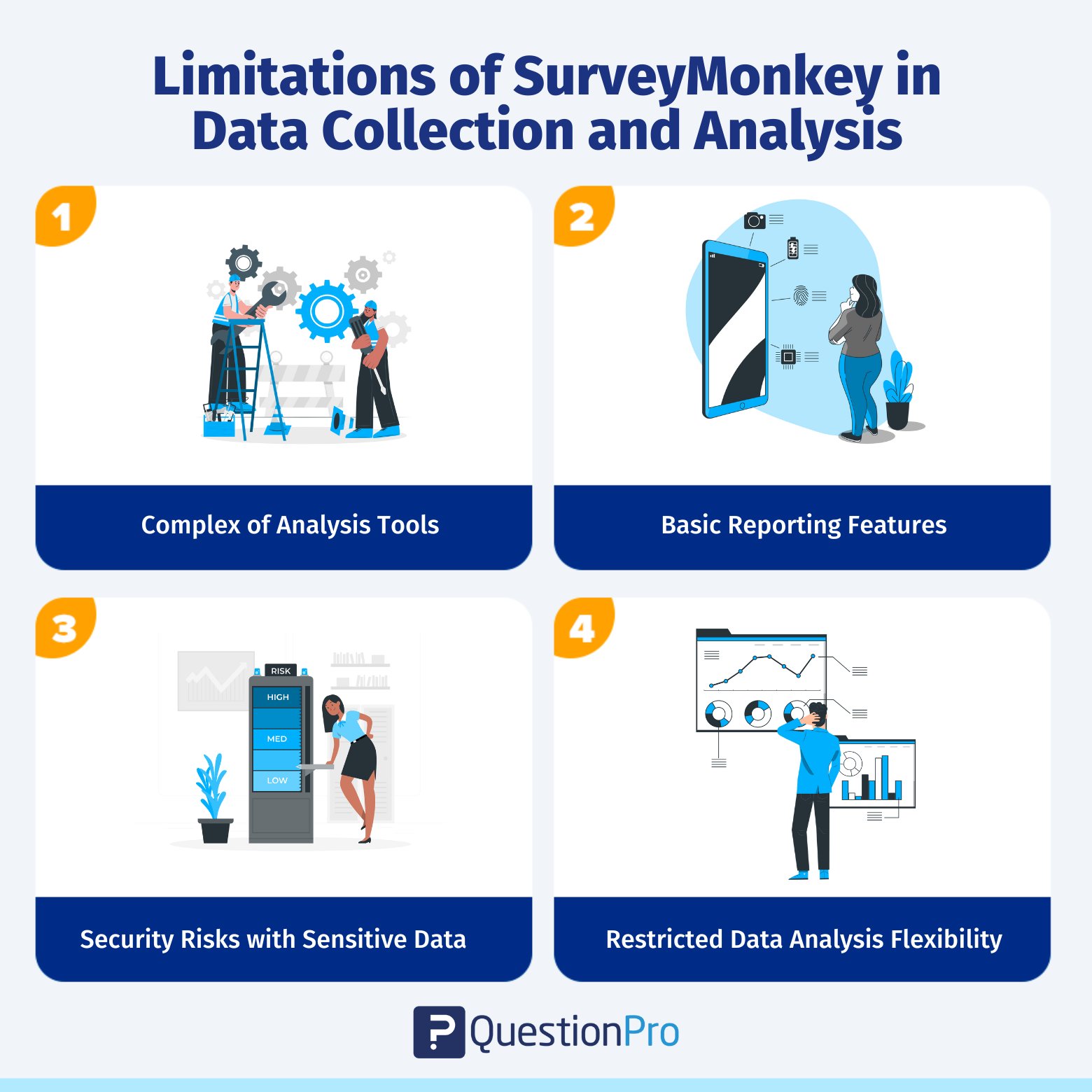
Online survey tools play a crucial role in helping businesses, educators, and researchers gather insights quickly and efficiently. SurveyMonkey is one of the most recognized platforms for creating and distributing surveys. It has many solutions, but it’s not without its flaws. In fact, understanding the disadvantages of SurveyMonkey is essential before deciding whether it’s the right fit for your survey needs.
Despite its popularity, SurveyMonkey presents several challenges, from pricing concerns to limited customization on free plans. For some users, SurveyMonkey alternatives like QuestionPro may offer greater value, especially when flexibility and budget are key considerations.
In this blog, we’ll explore the five major drawbacks you should know before choosing SurveyMonkey, helping you make a more informed decision for your data collection strategy.
5 Key Disadvantages of SurveyMonkey You Should Know
SurveyMonkey is one of the most recognized survey tools out there. It’s easy to use and great for quick surveys, but like any platform, it has its downsides. If you’re thinking about using it for your business, research, or even personal projects, it’s important to know what you’re getting into. Here are five key disadvantages to keep in mind before you commit:
1. Poor Survey Design and Survey Distribution
While SurveyMonkey makes it easy to create and distribute surveys, its design customization features leave much to be desired, particularly for businesses aiming to present a strong, consistent brand identity.
Key Limitations:
- Minimal control over fonts, colors, and layout
- Limited options to incorporate logos or branded elements
- Surveys may look generic and fail to reflect your brand personality
- Advanced design capabilities are only available on higher-tier paid plans
If creating a visually polished, on-brand survey is important to you, SurveyMonkey’s design tools may feel too basic or restrictive, especially compared to more flexible competitors.
2. Question Randomization Isn’t as Simple as It Should Be
Randomizing questions or answer choices is a helpful way to keep surveys fair and reduce bias. It prevents people from just clicking the first option they see and gives you more accurate results. SurveyMonkey does have this feature, but actually using it can be more frustrating than you’d expect.
The problem is that randomization is pretty limited, especially if you’re on a free or basic plan. You don’t get much control over what gets randomized, and the setup process isn’t very intuitive. If you’re not used to working with survey tools, it can feel a bit confusing and easy to mess up.
It also gets tricky when you start combining randomization with other features like skip logic or branching. Things can break or not work the way you intended, which can throw off your whole survey. So if you’re hoping to use randomization to improve your data quality, just know that it might take some extra effort and might not give you the flexibility you’re looking for.
3. Downloading Your Data Can Be a Hassle
Collecting survey responses is only half the job—being able to easily access and analyze that data is just as important. Unfortunately, SurveyMonkey doesn’t make this process as smooth as it could be, especially for users on the free plan.
If you’re using the free version, your ability to download results is extremely limited. You can view individual responses online, but exporting them into formats like Excel or CSV usually requires upgrading to a paid plan. Even then, the export experience isn’t always user-friendly.
Some common pain points include:
- Most useful export formats (Excel, CSV, SPSS) are locked behind paywalls
- Free users can’t download full datasets
- Exported files can be messy or poorly formatted
- Advanced filtering and reporting features are only available with higher-tier plans
This can be a major headache if you need to run detailed analysis outside of SurveyMonkey or share clean reports with a team or client. You might find yourself spending more time reformatting data than actually working with it.
In short, if your project depends on pulling and analyzing results outside the platform, be prepared for limitations unless you’re willing to pay for one of SurveyMonkey’s more expensive plans.
4. Survey Logic Can Be Confusing to Set Up
Logic features like skip logic and branching are great tools that help you create smarter, more personalized surveys. They let you guide people through different question paths based on how they respond, so each person gets a more relevant experience. SurveyMonkey does offer these features, but setting them up isn’t always easy.
If you’re new to survey tools or don’t have a lot of technical experience, the logic setup can feel pretty overwhelming. The platform doesn’t always offer clear guidance, and it’s easy to make small mistakes that can break the flow of your survey or confuse your respondents.
Even if you’re on a paid plan, the setup process doesn’t always feel intuitive. You might end up spending more time troubleshooting the logic than actually building your survey.
5. High Price
SurveyMonkey has a solid reputation and plenty of useful features, but most of the ones people actually need aren’t available on the free plan. Things like exporting your data, customizing your branding, or using advanced logic often require you to upgrade. And for freelancers, small teams, or anyone on a tight budget, those costs can add up fast.
What’s more, the pricing structure can feel a bit frustrating. You might find yourself needing just one specific feature, such as skip logic or file export, but have to pay for an entire higher-tier plan to get it. When you compare that to free tools like Google Forms or more affordable options like QuestionPro, it’s easy to wonder if SurveyMonkey is really worth the price—especially if you’re only sending out the occasional survey.
To be fair, SurveyMonkey is a powerful platform with lots to offer. But unless you’re running surveys regularly and need the full feature set, it might be more than you actually need and more than you want to spend. If budget is a concern, it’s worth exploring other tools that give you more flexibility for less money.
Other Limitations of SurveyMonkey in Data Collection and Analysis
While SurveyMonkey is widely used for its user-friendly survey creation and data collection tools, it does have several limitations when it comes to analyzing the survey data. For users who need more than basic insights, these constraints can quickly become apparent. From complex reporting needs to handling sensitive data, here are the main limitations to consider:

- The complexity of Analysis Tools
SurveyMonkey’s data analysis tools can feel overwhelming, especially for those without a background in data analysis. The platform doesn’t offer as much flexibility or depth as some users may require.
- Basic Reporting Features
The reporting features are useful for quick insights, but they lack the ability to generate complex graphs or customized charts. Users seeking advanced visualizations may need to turn to external tools for support.
- Security Risks with Sensitive Data
While SurveyMonkey provides strong security measures, users must remain cautious when collecting sensitive data. There’s always some risk involved when gathering personal or confidential information.
- Restricted Data Analysis Flexibility
Despite being excellent for collecting data, SurveyMonkey’s analytical tools are limited in depth and customization, making it difficult to perform in-depth analysis or create tailored reports directly within the platform.
Why Choose QuestionPro over SurveyMonkey?
If you’ve been frustrated by SurveyMonkey’s limitations, you’re not alone. While it’s a popular tool, many users find it lacks the flexibility and value they need, especially as their survey needs grow. That’s where QuestionPro stands out. It offers more features, better customization, and a user-friendly experience, often at a more affordable price point.
Here’s how QuestionPro addresses the key issues many users face with SurveyMonkey:
1. Better Survey Design and Branding
With QuestionPro, you can easily customize your survey to match your brand without needing advanced design skills or expensive upgrades. Here’s what you can do:
- Upload your company logo for consistent branding
- Customize colors, fonts, and layout to reflect your brand identity
- Use professionally designed templates to speed up survey creation
- Add a custom “Thank You” page for a polished finishing touch
- Access these features even on the free plan—no upgrade required
These tools help you create surveys that feel like a natural extension of your business, not just a generic form. Whether you’re sharing a link with customers or embedding it on your website, your survey will look and feel professional.
QuestionProTip: If branding matters to you, QuestionPro makes it easy to create surveys that look good and align with your business, without forcing you into a higher pricing tier.
2. More Control with Question Randomization
Sometimes, showing everyone the same set of questions isn’t ideal, especially if you’re testing different versions of a question or trying to avoid response bias. That’s where QuestionPro’s randomization really comes in handy. It doesn’t just let you shuffle the order of questions; it actually lets you randomly show just one question from a group, which can make your surveys feel more dynamic and help you collect cleaner, less biased data.
For example, imagine all your respondents answer questions 1 and 2. After that, you want them to see just one image question, either Q3, Q4, or Q5, picked at random. Then, everyone moves on to a thank-you message (Q6). QuestionPro makes this easy to set up without requiring any complicated workarounds.
Here’s how it works in practice:
- You place a Randomization Logic step just before the group of questions you want to randomize
- Select the option to “Randomly display one question” from that group
- Pick which questions you want included (like Q3, Q4, and Q5)
- Set all of those to branch to the same follow-up question (in this case, Q6)
- Add internal notes for your team, if needed—respondents won’t see them
A few things to keep in mind
You can’t control which specific question gets shown or how often each one appears, and QuestionPro doesn’t track which version each respondent saw. Also, while you can use multiple randomizers in one survey, they can’t overlap or nest within each other.
All in all, QuestionPro gives you a simple but powerful way to randomize questions in a smart, controlled way, perfect for when you want to test different options or just keep things fresh for your respondents
3. Easier and More Flexible Data Downloads
QuestionPro takes a more user-friendly approach. You can export your data even on the free plan in formats like Excel, CSV, or PDF. The files come out clean and well-organized, so you can start analyzing your results right away without spending time fixing formatting issues.
Whether you’re working solo or sharing results with a team, having flexible and reliable access to your data makes a big difference.
QuestionProTip: QuestionPro gives you the freedom to download your results quickly and easily, without forcing you to upgrade just to access the basics.
4. Simple and Visual Logic Setup
Adding logic to your survey, like skip logic or branching, can really improve the experience for respondents. It helps guide people through questions that are relevant to them, based on their answers.
QuestionPro makes this process much easier. Its visual logic builder is intuitive and beginner-friendly, so you don’t need to be tech-savvy to create smooth, personalized question flows. You can clearly see how different paths connect and make adjustments without getting lost in a mess of menus or settings.
This setup is great whether you’re just starting out or building more advanced surveys. It helps you avoid mistakes, saves time, and makes your surveys feel much more polished.
5. More Value for the Price
QuestionPro offers more features at a better price. Even its free plan includes tools that SurveyMonkey locks behind paywalls. For startups and small businesses, this means you can build powerful surveys without overspending.
- Generous free plan with fewer limits
- Paid plans offer more features for the money
- Better option for budget-conscious users
Learn More: QuestionPro vs SurveyMonkey: Software Comparison
Other Advantages of QuestionPro
QuestionPro makes it easy not just to collect data, but to actually understand it. Whether you’re running a quick survey or a larger research project, the platform gives you the tools to analyze results without needing technical skills.
Advantages:
- Instantly generate relevant survey questions using QuestionPro AI
- Advanced filtering and reporting options
- Mobile and multilingual survey support
- Real-time data tracking and live reports
- Strong privacy and security features
Conclusion
If you only need to run a simple survey occasionally, SurveyMonkey can do the job. However, if you want more freedom to design your surveys, it’s essential to understand the disadvantages of SurveyMonkey, as it can become frustrating quickly. Many users find that they need more than what SurveyMonkey offers, especially as their needs grow.
Here, QuestionPro survey builder proves to be a better fit. It addresses many of the pain points SurveyMonkey users face. Whether it’s professional survey design or advanced logic, QuestionPro gives you the tools to create surveys that are meaningful and high-quality without unnecessary roadblocks or hidden costs.
Selecting the right survey platform comes down to what matters most to you. If SurveyMonkey isn’t meeting those needs, QuestionPro might just be the upgrade you’ve been looking for.
Frequently Asked Questions (FAQs)
Answer: Some of the key disadvantages of SurveyMonkey include limited design customization, restricted features on the free plan, complicated logic setup, and high pricing for advanced tools.
Answer: SurveyMonkey offers a free plan, but it’s very limited. You can only ask a small number of questions, collect a limited number of responses, and cannot export full data.
Answer: Yes, limitations like poor design flexibility, confusing logic setup, and restricted data exports can impact how users respond and how easily you can analyze your results.
Answer: Many users look into tools like Typeform or QuestionPro, which offer better customization, easier logic, more data control, and better value for the price.
Answer: SurveyMonkey can work for professional use, but its disadvantages, like limited design options and a lack of advanced analysis tools, can be a barrier for some teams.







